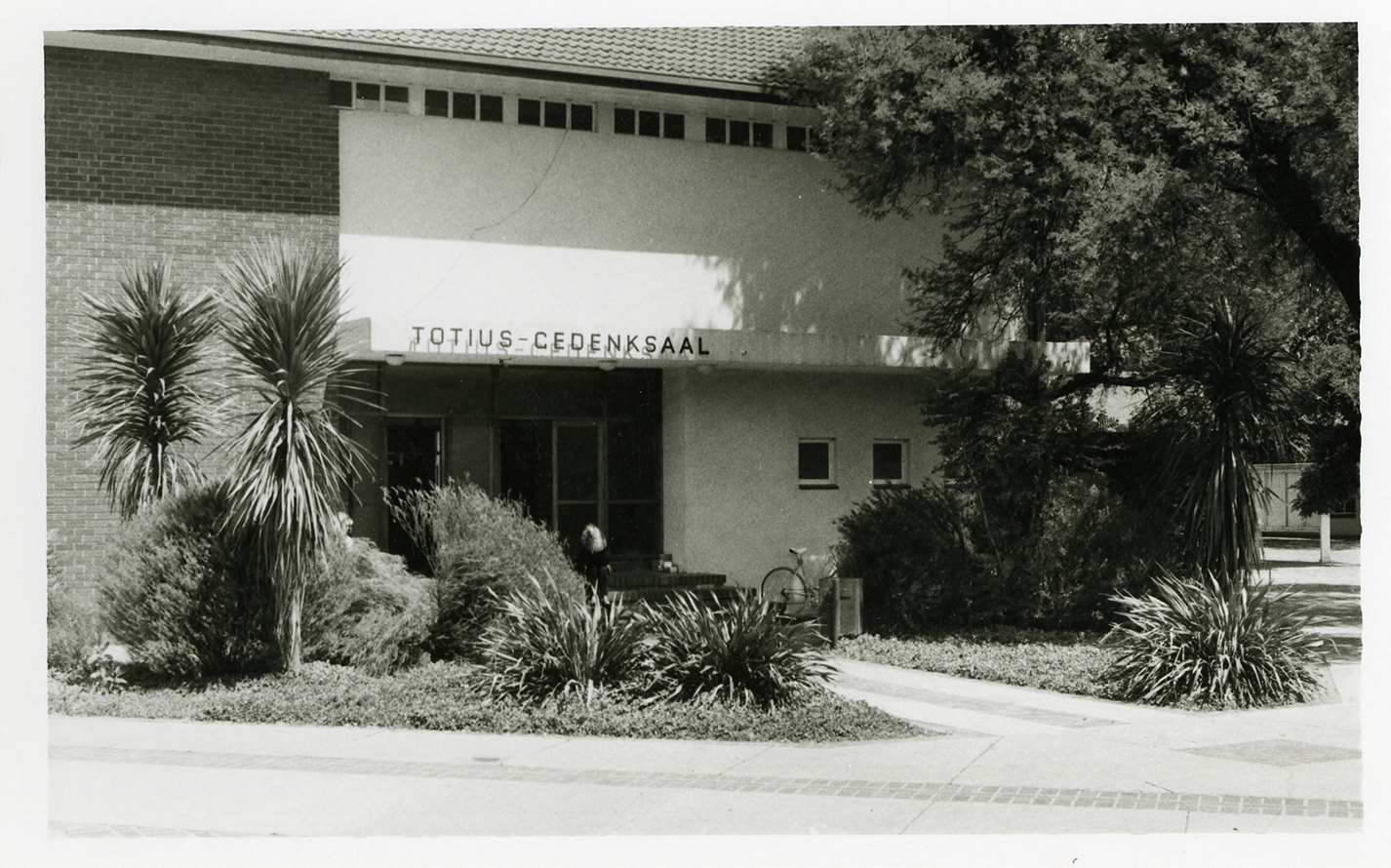Totius Hall (F6)

- In the early 1950s the lack of recreational facilities for students were one of the most important deficiencies in the physical planning of the PUC. Where the Totius Hall stands today, between the Main Building and the Heimat Residence, was a galvanised iron building that once was a laboratory. By 1950 it was the office of the Student Council, its archive and store room and student hall, where 200 people could fit in, standing room only. It was already way too small, because by 1949 the PUC already had 700 students.
- With the planning of the new student hall, it was decided that it should be able to accommodate 700 students with a further 300 seats in the gallery.
- When building started in September 1953, the students had raised only £4 300. This was in spite of the fact that they enthusiastically shook their collecting tins during Joy Day Celebrations (later RAG) to collect funds to build the hall. Subsidy from the government and a loan acquired by the students were sufficient to cover building costs. The Alabama Student Company donated the proceeds from their tours to the building fund.
- The hall was officially opened on 12 March 1954 by the then Rector, Prof JC van Rooy. The 1 000 seats were not enough, as by 1953 there were already more than a thousand students on campus.
- For years the Totius Hall was the ‘living room” of the university with a myriad of concerts, shows and many other functions.
- In 1969 Francois Venter, editor of Wapad, wrote how overcrowded the Hall was during sing-songs and that many students had to stand under the trees next to the hall to participate.
- By 1970 the Totius Hall was literally bursting at the seams. Horst Bütow recalls that in his first year, 1970, they had to attend the Court of Hades. The 800 first years were forced into the front part of the Hall (a space that could only accommodate 500). The seniors occupied that back part of the Hall and the gallery. Then the order “Sit!” was yelled and he says “if you did not sit immediately, you didn’t sit at all. And then you heard the windows of the Hall breaking as the students fell against it.”
- Plans for a new student centre were already being made in the early 1960s, but the new Hennie Bingle Student Centre was only completed in 1979 and inaugurated in 1980.
- Afterwards the Totius Hall came under control of the Culture Council of the Central Student Council and was managed by the Culture Office, later NWU Arts.
- The Totius Hall is mainly used for student activities and as a rehearsal space for tour groups, in spite of the many requests and entreaties made by various departments to acquire it.

This architectural drawing of how the new ‘student hall’ was to look appeared in Die Vlotjie, a supplement to Wapad of 7 August 1953.
“This is what every Puk student collect for every Saturday for all their worth,” recounts the caption. “A building that no other student hall in the country should take a back seat to.
Many attempts had already been made to acquire the necessary funds to realise this ambition and Saturday’s attempt must do this.
Otherwise it is going to be tough to acquire more funds.
On every PUC students rest this “momentous task to join the fray to make our Joy Day Celebrations (later RAG) a success!
The costs to build the student hall will be £14 000. Come on, Pukke, and see what we all can do!”
Totius of the Totius Hall
The Totius Memorial Hall, the actual name of the Totius Hall, was named after Prof JD du Toit. He is better known as the poet, Totius. His fellow students, who studied with him at the Theological School of the Reformed Church in Burgersdorp in 1896, knew him as Japie du Toit. It was, however, during the Anglo-Boer War, when he studied at the Vrije Universiteit in Amsterdam, that he acquired the pseudonym, “Totius”. This word is derived from the Latin word, meaning “entirety” or “from everybody”. This relates to the fact that during his student years in Burgersdorp, he was known as “our chief poet” or “our poet”. After the war he served the Reformed Church Potchefstroom and endeavoured to relocate the Theological School and its Literary Department from Burgersdorp to Potchefstroom. In 1911 he accepted a professorate at the Theological School and was appointed as rector in 1913. Afterwards he resided in the Rector’s Residence which is today the Totius House, one of the three house museums of Potchefstroom. Totius published numerous volumes of poetry and is also widely known as one of the five Bible translators, who, for the first time, translated the Bible into Afrikaans. He passed away on 1 July 1953 in Pretoria, shortly before building of the student hall commenced and it was named after him.

Prof JD du Toit (Totius) (1877-1953)
